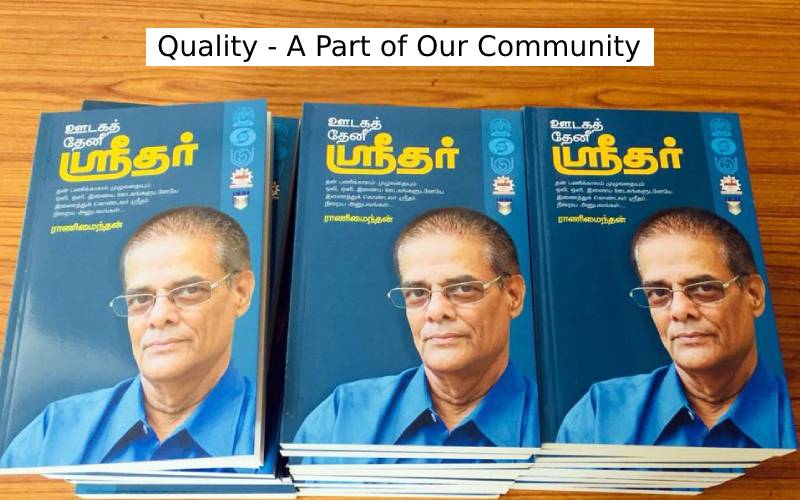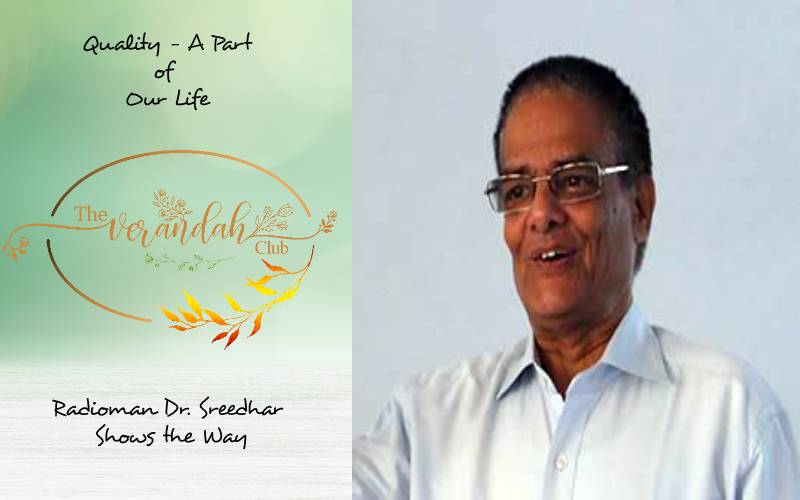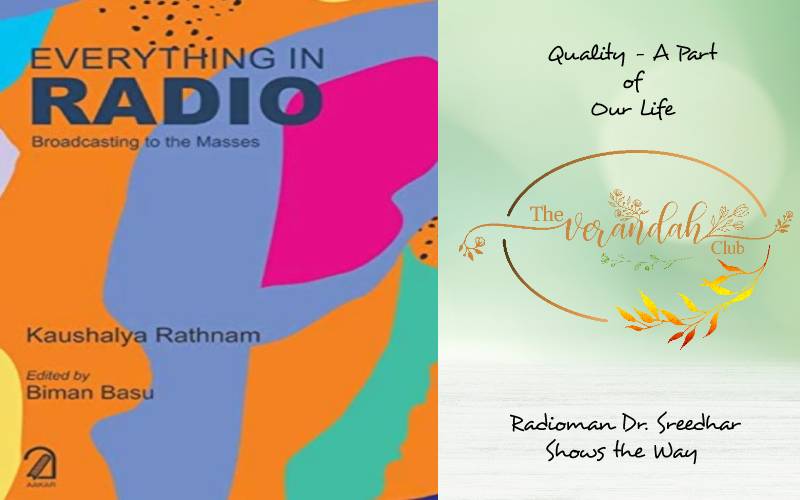
The Radioman, Dr. Sreedhar Shows the Way
Rajan, a Radioengineer, is the core of the movie, ‘Andha Naal’ (1954). He wants to sell radios at a low cost to the people, but the innovation of this intelligent inventor does not see the light of the day. This makes him change his ways and he ends up being a traitor. The radio was an important medium for a long time, and it still continues to be so. The Radio Station recording of ‘Vaishnava Janato’ by M. S. Subbulakshmi was made for Gandhi those days. Today, we have the Government Radio, Private Radio Stations and Community Radio Stations throughout the world. People are continuing to enjoy good music because of the same. The movie, ‘Andha Naal’ signifies the importance of the Radio.
Tapovani is an initiative by the residents of the senior citizens home, Tapovan. This home was founded by M. N. Varadarajan. One of the residents, Dr. R. Sreedhar has been responsible for this activity. The senior citizens are now recording, editing and broadcasting from the home itself. The experience of the Radioman Sreedhar was the main input. This Radio pioneer was born to Ramamurthy and Pankajam and he lived in Tambaram (Chennai) for the first 37 years of his life. His maternal grandfather, T. K. Gopal Iyer had been a Tamil Professor in MCC (Madras Christian College). Sreedhar holds a doctorate in chemistry, and he began his career as a research scholar and demonstrator in chemistry. He had also worked in two other colleges (Gudiyatham & Erode).
“I was left in the lurch by 1976. Had to leave MCC and tried to get a position elsewhere. Did not know a place outside Tamil Nadu those days. I was familiar with All India Radio and was also writing for newspapers and magazines. The magazines included ‘Kalaimagal,’ ‘Kannan’ (Children's magazine) and ‘Manjari.’ I used to write on science in ‘Kannan.’ Wrote science articles for ‘Swadesamitran’ too. AIR (All India Radio) had the ‘Ilaya Bharatam’ programme, and I participated in it. One person identified my science & Tamil combination. I was asked to do interviews for AIR. My Radio life began thereafter. I interviewed H. N. Setna, Raja Ramanna, Nayudamma, Kulandaiswamy, G. Parthasarathy and the Nobel Laureate, Dorothy Hodgkin,” said Dr. Sreedhar proudly.
He continued, “Later, I applied for the job of the Duty Officer in AIR, but my over qualification stood in the way. Subsequently, the Five-Year Plan of Prime Minister, Indira Gandhi was set to create Science Popularisation Cells throughout the country. These cells were in need of one officer and reporter. I got a reporter job, and the pay was Rs.550. Much more than the pay of a professor. I started science communication. Was lucky to be the first to start science broadcasts in India. What I said became law. I could not get an officer posting and later moved to Coimbatore AIR.”

Initially, the Radioman did not get an opportunity to do programmes for one year. A kitchen was the recording room those days and it was in Tatabad, Coimbatore. He would request the neighbour not to wash clothes until the scheduled recording got over. Later, it was the meeting with Prof. G. R. Damodaran of the PSG Institutions which changed things. He permitted Dr. Sreedhar to not only use his auditorium but also let other college students within. GRD would also give SKC (Sweet, Karam & Coffee) to the students. This made other colleges follow the suit. Coimbatore was a place known for its cooperation, and the staffs were happy. Delhi trusted the Radioman Dr. Sreedhar, and this created a lot of possibilities. Finally, the Coimbatore Vanoli Nilayam (Radio Station) was born on 15/8/1978. NTC (National Textile Corporation), CTC (Cheran Transport Corporation) had also extended their support. The recommendations of CODISSIA and the Indian Chamber of Commerce had been accepted. However, ‘Vivid Bharathi’ had to come and it did not happen.
Dr. Sreedhar met Dr. M. S. Swaminathan, and this eventually led to the programme, ‘Ariviyal Peravai.’ “We had 52 scientists and 52 questions. A Sujatha drama and a Kannadasan song was part of it. A non-conventional energy village was done. The governor, ministers and vice chancellors came in. People at Delhi saw it and they wanted it everywhere. I would take bold steps and did not bother about consequences. Taking tuitions was my Plan B always! Ah, I now remember the Telecommunications Day on May 17. We had a Radio drama and got recognitions too. I remember the hotlines which were used."
The Radioman proceeded, "We had a bullock cart, bus, ship and an aeroplane as the modes of transport for the programme. The members of the press were in the bus. If I remember right Rekha Shetty was in the ship, Jennifer Arul moved in the train and Malini Seshadri was in the aeroplane. All of this had been made possible with just the eighteenth-century wireless transmitter. One small thought, it was used in the twentieth century! It was a teleconference on the move at a time when cell phones were not in use. We used bullock carts in Gujarat, Leh, Lakshadweep, Port Blair and Shillong once. M. B. Srinivasan would sing. The kids in Leh would repeat and other kids in different locations sang. It looked as though they sang the same in chorus. Well, we did telemedicine with the help of neurosurgeon, Dr. Kalyanaraman. He consulted on high altitude fever. Things kept happening,” smiled Dr. Sreedhar, the Radioman.
Dr. Sreedhar had become an authority on radios. The ‘Coimbatore Ariviyal Peravai’ was a big hit. It took place for 14 days. It was a textile city and hence they had a fashion parade. A solar hut, an NLC power plant and an Apple Satellite Model were part of the show. G. K. Sundaram of the Lakshmi group of Coimbatore sponsored the satellite and the escalator. 24 colour televisions were provided by UMS, and it was to the interest of G. D. Gopal. The Government of India sent Dr. Sreedhar to the USA. He did a lot more with science and the radio. “The Communist party was using my material and resources. The propaganda was in their own style. However, this did not deter me. I had crossed many obstacles by then. Well, was fortunate to do the World's largest children's science serial on radio in 1991. It was it eighteen languages and 176,000 post cards were sent to people. Prizes were given. ‘Manav Ka Vikas’ is still going on. The DATE (Drug, Alcohol, Tobacco, Education) initiative witnessed a big hit. 140,000 people wrote letters. A 26-episode drama was in the scheme of things. People drinking and beating was the most common feature. So many more things took place,” chuckled Dr. Sreedhar.
The Radioman had met Hemamalini and covered Miss India, Filmfare Awards etc. He was the only one without a CBI enquiry on him. He worked in Kolkata and had to face several issues for he was not a Bengali. However, they liked him later. DD Bangla was born. It was a pro-saree movement time in Kolkata. Dr. Sreedhar left the television arena after having put in five years. He came back to the world of Radios. The pioneer put in a lot of work with IGNOU Gyanvani. He had many firsts to his credit. Dr. Sreedhar was responsible for ‘Community Radios’ in India. He has helped more than 150 Radio Stations. His guidance would help people to create Community Radios. The Radioman's knowledge can help others in numerous ways.

The first senior citizen podcasting in India is recently brought into effect by him. It will be supported by the Ministries of Social Justice & Empowerment and Ministry of Science & Technology. His student, Kaushalya Ratham has chronicled his work through the book - ‘Everything in Radio: Broadcasting to the Masses.’ It is edited by Biman Basu. The Tamil biography is ‘Oodaga Thenee Sreedhar’ by Rani Maindhan. Kaushalya Rathnam had done her M.Sc. in Electronic Media (Department of Media Sciences) in Anna University.
Kaushalya Ratham, the student of Dr. Sreedhar got the best Radio Jockey Award in 2007. She had been his student along with many other achievers when Dr. Sreedhar was the Director – Audio-visual Research Centre (Anna University). “We got the first Campus Community Radio. Dr. Sreedhar is the Radio Pioneer in our country. He is the only one to have many experiences in field of broadcasting and television. My teacher has too many firsts. We can have a long list. He will always roll out something new to bring out the potential in everybody. Students engaged with his activities would always stay inspired. Many of them are still in touch with him. He is really enterprising and does new things everywhere. Therefore, we found him to be an amazing person. He always has a zeal in thought and action. Ideas were shared by him, and we found him to be ever innovative. He would make things happen. All the students developed an affinity towards him, and they are in touch with him even now. Many of them are doing well in the media world. Dr. Sreedhar is recognised by his students and colleagues alike as a leader and innovator. He is everything in the world of radio literally,” stated Kaushalya Rathnam.
Dr. Sreedhar is an Emeritus Professor, Apeejay Stya University and former Director, Commonwealth Educational Media Centre for Asia. He has also served as the Director, Electronic Media Production Centre (IGNOU - Indira Gandhi Open University) and has also held senior positions in Door Darshan, All India Radio. Dr. Sreedhar has produced several award-winning documentaries during his long career. He is a pioneering expert in conceptualising and framing guidelines for Community Radio in India.
He spoke about technology, and Community Radios in India, “Digital Radio is the answer. Digital devices are booming, and everyone has internet connectivity. Community Radio Stations should evolve themselves into Digital Radio and solve the problems of frequency and power. The earlier we embrace Digital Radio, the better it will be for Community Radio. I am surprised to see how Community Radios are working. There is no Community Radio training. Most of the capacity building programmes are not doing things for Community Radios. There was a certificate course for Community Radio at IGNOU, but that does not attract students anymore. Professionals who are in the Community Radio world are former AIR people, journalists, or they are from the world of advertising. Most of them are working blind. Some of them are activists or NGO people and they are good with their subjects. They are not fully equipped. Some are successful and some are not."
"The need is for a formal yearlong or six-month training for people who will be working as grass-root reporters at Community Radio Stations. Community Radio practitioners should have their own style of broadcasting and not just follow the traditional All India Radio (AIR) Broadcasting or the traditional radio jockey oriented commercial broadcasting methods. Capacity building is the need of the hour. Community Radios can do a lot of good. They can build on our culture and tradition. Inculcate morals and ethics too,” Dr. Sreedhar extended his opinion.
Dr. Sreedhar's Ishta Deivam is Tirupathi Venkatachalapathy. A chat with the radioman is sure to be very educative. It will help people to use media for promoting Indian culture and tradition.
Mr. Rajesh Govindarajulu is one of the founding members of the Verandah Club Pvt. Ltd. He is a leading columnist, historian, jeweler, entrepreneur, and a heritage enthusiast who is earnestly working to revive the past in the light of the present. Experiential learning about the history of Coimbatore is his main course of interest and he is also a panel member of many colleges in the city.
NEXT ARTICLE

At the southernmost tip of this mesmerising ensemble lies the majestic Great Nicobar Island, boasting an impressive landmass of about 910 square kilom...

Bharath has always been a land traversed by spiritual masters/ Guru since time immemorial. These spiritual masters have always upheld the core princip...

South India contains its fair share of unique pilgrimage centres. These divine places of worship have a prominent Sthala Purana, devoted followers, di...